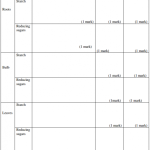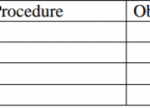KNEC KCSE Biology Paper 3 Question Paper / 2015 KCSE Bomet County Joint Examinations
2015 KCSE Bomet County Joint Examinations
Biology Paper 3
Study the photographs U, V, W and X showing fruit specimens that are open to expose the interna partsl.
(a) Name the parts labeled A, B, C and D (4marks)
A………………………………………………………………………….……………………………….
B…………………………………………………………………………….…………………………….
C………………………………………………………………………………………….……………….
D……………………………………………………………………………..……………………………
(b) Identify the type of fruit in photograph: (2marks)
U……….………………………………………………………………………………………….
W………..…………………………………………………………………………………………
(c) What type of placentation is found in the following fruits: (3mks)
U……………………………………………..……………………………………………………..……..
V…………………………………………………………………………………………………………..
W…………………………………………………………………………………………………….…….
(d) How is the specimen in photograph W adapted to its functions? (2marks)
…………………………………………………………………………………………………………………
……………………………………………………………………………………………………….……….
…………………………………………………………………………………………………………………
……………………………………………………………………………………………….……………….
(e) Which part of a flower develops into the region labeled R in the photograph X. (1mark)
………………………………………………………………………………………………………………
12 marks
Below is a diagram showing a type of metamorphosis exhibited by a butterfly
(a) Give the name of the type of metamorphosis in the diagram above. (1mark)
…………………………………………………………………………………………………………………………………………………
(b) Write down two importance of metamorphosis. (2marks)
…………………………………………………………………………………………………………………………………………………
…………………………………………………………………………………………………………………………………………………
(c) Name stages Q and R (2mks)
Q……………………………………………………………………………………………………………
R……………………………………………………………………………………………………………
(d) Differentiate the biological activities in the development stages R and S. (4marks)
…………………………………………………………………………………………………………………………………………………
…………………………………………………………………………………………………………………………………………………
…………………………………………………………………………………………………………………………………………………
…………………………………………………………………………………………………………………………………………………
(e)Name the two major hormones that are associated with metamorphosis in insects. (2marks)
…………………………………………………………………………………………………………………………………………………
…………………………………………………………………………………………………………………………………………………
(f) (i) Name the class to which the organisms in the diagram above belongs. (1mark)
…………………………………………………………………………………………………………………………………………………
(ii)Give a reason for your answer in f (i) above. (2marks)
………………………………………………………………………………………………………………………………………………..
…………………………………………………………………………………………………………………………………………………
14 marks
Label three test tubes P, Q and R. Into each test-tube, place 3ml of solution C.
a) Put a drop of solution C on a white tile and add a drop of iodine solution.
Record your observation. (1mark)
…………………………………………………………………………………………………………………………………………………
b) Add 3 drops of 0.1%sodium chloride solution and 2ml of solution A to test tube Q.
To test-tube R, add three drops of 1.4% sodium chloride solution and 2ml of solution A. Sodium chloride is a source of sodium ions. Place the test tube P, Q and R in a water bath maintained at 37oC for 30minutes. Using a drop of the solution from each test-tube, repeat the procedure in (a) above and spare the rest for the next question. Record your observation in the table below. (3marks)
c) (i) Put 2cm3 of solution from test-tube P in a clean test tube and add 2cm3 of Benedict solution, shake then heat the mixture to boil. Record your final observations in the table below. Repeat the procedure for solution Q and R. (3marks)
(ii) Account for your results in test-tubes Q and R. (4marks)
…………………………………………………………………………………………………………………………………………………
…………………………………………………………………………………………………………………………………………………
…………………………………………………………………………………………………………………………………………………
…………………………………………………………………………………………………………………………………………………
…………………………………………………………………………………………………………………………………………………
…………………………………………………………………………………………………………………………………………………
d) Why was the test-tube P included in the experiment? (1mark)
…………………………………………………………………………………………………………………………………………………
e) Suggest the identity of solution (1mark)
…………………………………………………………………………………………………………………………………………………
f) Why was the water bath maintained at 37o C (1mark)
…………………………………………………………………………………………………………………………………………………
14 marks









